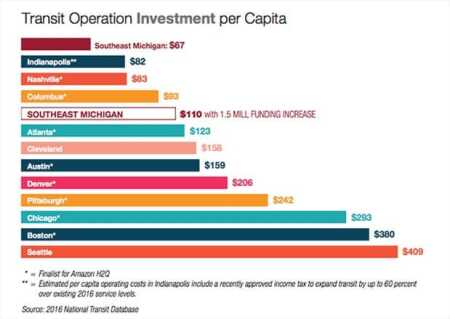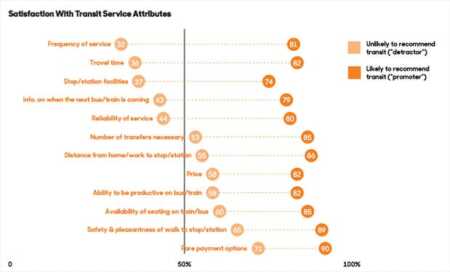Detroit’s metropolitan area is slowly growing again, which means it’s time to focus on planning to accommodate more people in an area already light on transit infrastructure. For a place long known as Motor City, it has been an uphill battle to become a transit-oriented community.
Southeastern Michigan lags many U.S. regions in terms of transit operation investment, despite being the 14th-largest region in the country. This stems partially from the 2016 vote against a regional transit millage, which would have provided funding to both improve and expand. Instead, voters chose to reject it, stalling progress for another two years.
By comparison, Seattle spends more money per capita on investing in its transit infrastructure—so far to great success. As record numbers of people have moved to the area and are working in the downtown core, the drive-alone rate has only decreased from 35 percent to 25 percent. This was made possible by a deliberate, concerted effort to invest in and push for more mobility options.
Southeast Michigan ranks behind many other comparable areas in per-capita spending on transit operation investment—which brings us to Connect Southeast Michigan, the newly introduced regional transit plan that includes all four counties (Macomb, Oakland, Washtenaw, and Wayne). Residents will vote for (or against) it this November. If approved, it would provide $5.4 billion in funding over 20 years.
“I just think we as a region [are] taking a much too casual attitude,” Mayor Mike Duggan said to the Detroit Free Press earlier this year. “If we don’t address [transit], we’ll keep falling further and further behind.” Indeed, the region as a whole is predicted to add nearly 400,000 households in the next 20 years, and this change will require extra planning to bring it up to speed while also preparing for the future.
What makes this plan different than the last? It focuses less on bus rapid transit and rail and more on simply increasing bus frequency. As it stands, the Detroit Department of Transportation’s on-time performance hovers between 60 and 70 percent, well below the industry standard of 90 percent.
Frequent service is one of the most important factors in overall rider satisfaction. Riders, both those who do and don’t have cars, are more likely to take transit that actually serves them well.
This graph, from TransitCenter, shows the gap in satisfaction between riders who would recommend their transit service and those who would not. The largest gaps were in frequency of service, travel time, and information about when the next bus or train was coming. Southeast Michigan’s current plan proposes adding 15 routes with at least 15-minute rush-hour frequency, which would make a huge difference and actually serve current transit riders, significantly improving their daily lives.
This type of plan is excellent for long-term transit improvements and growth, but what can the region do with its existing infrastructure in the short term?
One option would be to provide more bike options. The city debuted its bike-share system, MoGo, in May 2017 with 430 bikes. It follows the public/private partnership model as cities before it have done, and it reached 100,000 rides in fewer than five months. The demand for bike share is there, and the city actually already has much of this infrastructure in place. As of late 2017, there were 212 miles (341 km) of bike lanes in the city. Though most are not protected lanes, the city is working on increasing those numbers.
One of the biggest trends in the mobility world right now is the introduction of completely private, dockless bike-share companies. Many cities are trying this out on a pilot basis, as cities build out infrastructure and determine limits and regulations that should be set. From Washington, D.C.’s pilot, so far in progress for more than six months, the numbers suggest that dockless options are definitely adding riders to the streets.
For a city like Detroit, this could be a no-brainer. While traditional bike-share models can involve a large amount of upfront investment from the city, working with private companies can keep the cost to the city minimal, if anything at all, while adding large numbers of bikes on the streets for those who want them.
Another option would be to embrace ride-hailing apps such as Uber and Lyft as partners in the mobility game. Several smaller cities have entered partnerships with these companies to subsidize rides to and from transit stations as a way of quickly expanding their existing transportation networks. For example, Pinellas Park, Florida, worked with Uber to offer subsidies for all rides that ended at 20 designated transit stops.
It is essential to note that this is meant not to replace public transit, but to augment it as cities work on longer-term investments in creating a strong transportation network. The key is offering more options to supplement existing ones, while improving the overall transit landscape.
Detroit and other similar cities can still bring themselves into the future of mobility, so long as they make it a priority and get buy-in from all sides. The next few years will be crucial, and it will be exciting to see where it goes.
RACHEL KARITIS is the director of marketing at TransitScreen, a provider of real-time transit data. RYAN CROFT is a ULI member and chief operating officer of Transit Screen.






